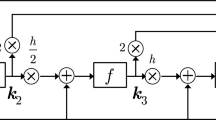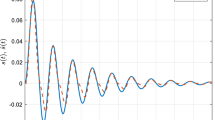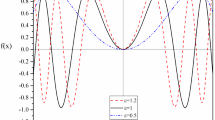Abstract
This paper presents a dynamic model based on neutrosophic numbers and a neutrosophic logic engine. The introduced neutrosophic logic/fuzzy adaptive Zeroing Neural Network dynamic is termed NSFZNN and represents an improvement over the traditional Zeroing Neural Network (ZNN) design. The model aims to calculate the matrix pseudo-inverse and the minimum-norm least-squares solutions of time-varying linear systems. The improvement of the proposed model emerges from the advantages of neutrosophic logic over fuzzy and intuitionistic fuzzy logic in solving complex problems associated with predictions, vagueness, uncertainty, and imprecision. We use neutrosphication, de-fuzzification, and de-neutrosophication instead of fuzzification and de-fuzzification exploited so far. The basic idea is based on the known advantages of neutrosophic systems compared to fuzzy systems. Simulation examples and engineering applications on localization problems and electrical networks are presented to test the efficiency and accuracy of the proposed dynamical system.










Similar content being viewed by others
References
Ansari AQ (2017). Keynote speakers: From fuzzy logic to neutrosophic logic: a paradigme shift and logics. pp 11–15, Jaipur, India. IEEE
Atanassov KT (1986) Intuitionistic fuzzy sets. Fuzzy Sets Syst 20(1):87–96
Ben-Israel A (1986) Generalized inverses of matrices: a perspective of the work of Penrose. Math Proc Camb Philos Soc 100(3):407
Ben-Israel A (2002) The Moore of the Moore–Penrose inverse. Electron J Linear Algebra 9:150–157
Christianto V, Smarandache F (2019) A review of seven applications of neutrosophic logic: in cultural psychology, economics theorizing, conflict resolution, philosophy of science, etc. Multidiscip Sci J 2:128–137
Dai J, Chen Y, Xiao L, Jia L, He Y (2022) Design and analysis of a hybrid GNN–ZNN model with a fuzzy adaptive factor for matrix inversion. IEEE Trans Ind Inform 18(4):2434–2442
Dean P, Porrill J (1998) Pseudo-inverse control in biological systems: a learning mechanism for fixation stability. Neural Netw 7–8:1205–1218
Dempster AG, Cetin E (2016) Interference localization for satellite navigation systems. Proc IEEE 104(6):1318–1326
Deng Y, Ren Z, Kong Y, Bao F, Dai Q (2017) A hierarchical fused fuzzy deep neural network for data classification. IEEE Trans Fuzzy Syst 25(4):1006–1012
Feng S, Wu H (2017) Hybrid robust boundary and fuzzy control for disturbance attenuation of nonlinear coupled ode-beam systems with application to a flexible spacecraft. IEEE Trans Fuzzy Syst 25(5):1293–1305
Hu Z, Xiao L, Li K, Li K, Li J (2021) Performance analysis of nonlinear activated zeroing neural networks for time-varying matrix pseudoinversion with application. Appl Soft Comput 98:106735
Huang F, Zhang X (2006) An improved Newton iteration for the weighted Moore-Penrose inverse. Appl Math Comput 174(2):1460–1486
Huang H, Fu D, Xiao X, Ning Y, Wang H, Jin L, Liao S (2020) Modified Newton integration neural algorithm for dynamic complex-valued matrix pseudoinversion applied to mobile object localization. IEEE Trans Ind Inf 17(4):2432–2442
Jia L, Xiao L, Dai J, Cao Y (2021) A novel fuzzy-power zeroing neural network model for time-variant matrix Moore-Penrose inversion with guaranteed performance. IEEE Trans Fuzzy Syst 29(9):2603–2611
Jia L, Xiao L, Dai J, Qi Z, Zhang Z, Zhang Y (2021) Design and application of an adaptive fuzzy control strategy to zeroing neural network for solving time-variant QP problem. IEEE Trans Fuzzy Syst 29(6):1544–1555
Katsikis VN, Mourtas SD, Stanimirović PS, Zhang Y (2022) Solving complex-valued time-varying linear matrix equations via QR decomposition with applications to robotic motion tracking and on angle-of-arrival localization. IEEE Trans Neural Netw Learn Syst 33(8):3415–3424
Katsikis VN, Stanimirović PS, Mourtas SD, Xiao L, Karabasević D, Stanujkić D (2022) Zeroing neural network with fuzzy parameter for computing pseudoinverse of arbitrary matrix. IEEE Trans Fuzzy Syst 30(9):3426–3435
Li W, Ma X, Luo J, Jin L (2021) A strictly predefined-time convergent neural solution to equality-and inequality-constrained time-variant quadratic programming. IEEE Trans Syst Man Cybern Syst 51(7):4028–4039
Liao B, Zhang Y (2014) Different complex ZFs leading to different complex ZNN models for time-varying complex generalized inverse matrices. IEEE Trans Neural Netw Learn Syst 25(9):1621–1631
Lin J, Lin CC, Lo HS (2009) Pseudo-inverse Jacobian control with grey relational analysis for robot manipulators mounted on oscillatory bases. J Sound Vib 326(3–5):421–437
Liu X, Yu Y, Zhong J, Wei Y (2012) Integral and limit representations of the outer inverse in Banach space. Linear Multilinear Algebra 60:333–347
Mallik S, Mohanty S, Mishra BS (2022) Biologically Inspired Techniques in Many Criteria Decision Making, volume 271 of Smart Innovation, Systems and Technologies, chapter Neutrosophic Logic and its Scientific Applications. Springer, Singapore
Naik J, Dash S, Dash P, Bisoi R (2018) Short term wind power forecasting using hybrid variational mode decomposition and multi-kernel regularized pseudo inverse neural network. Renew Energy 118:180–212
Noroozi A, Oveis AH, Hosseini SM, Sebt MA (2018) Improved algebraic solution for source localization from TDOA and FDOA measurements. IEEE Wirel Commun Lett 7(3):352–355
Penrose R (1956) On a best approximate solutions to linear matrix equations. Proc Cambr Philos Soc 52:17–19
Precup R-E, Tomescu M-L, Dragos C-A (2014) Stabilization of Rössler chaotic dynamical system using fuzzy logic control algorithm. Int J Gen Syst 43(5):413–433
Salama AA, Alhasan KF, Elagamy HA, Smarandache F (2021) Neutrosophic dynamic set. Neutrosophic Knowl 3
Smarandache F (1998) Neutrosophy: Neutrosophy probability, set and logic. American Research Press, Analytic Synthesis and Synthetic Analysis
Smarandache F (2001) A unifying field in logics: Neutrosophic logic, neutrosophic set, neutrosophic probability and statistics (fourth edition). arXiv:math/0101228
Smarandache F (2003) Neutrosophic logic—generalization of the intuitionistic fuzzy logic. arXiv:math/0303009
Stanimirovic PS, Katsikis VN, Jin L, Mosic D (2021) Properties and computation of continuous-time solutions to linear systems. Appl Math Comput 405:126242
Stanimirović PS, Katsikis VN, Li S (2019) Integration enhanced and noise tolerant ZNN for computing various expressions involving outer inverses. Neurocomputing 329:129–143
Stanimirović PS, Katsikis VN, Zhang Z, Li S, Chen J, Zhou M (2020) Varying-parameter Zhang neural network for approximating some expressions involving outer inverses. Optim Methods Softw 35(6):1304–1330
Stanimirović PS, Stojanović I, Katsikis VN, Pappas D, Zdravev Z (2015) Application of the least squares solutions in image deblurring. Math Probl Eng, 2015. Article ID 298689
Tan Z, Hu Y, Xiao L, Chen K (2019) Robustness analysis and robotic application of combined function activated RNN for time-varying matrix pseudo inversion. IEEE Access 7:33434–33440
Wang A, Liu L, Qiu J, Feng G (2019) Event-triggered robust adaptive fuzzy control for a class of nonlinear systems. IEEE Trans Fuzzy Syst 27(8):1648–1658
Wang F, Chen B, Liu X, Lin C (2018) Finite-time adaptive fuzzy tracking control design for nonlinear systems. IEEE Trans Fuzzy Syst 26(3):1207–1216
Wang H, Li J, Liu H (2006) Practical limitations of an algorithm for the singular value decomposition as applied to redundant manipulators. In: 2006 IEEE conference on robotics, automation and mechatronics, pp 1–6
Xiao L, Liao B, Li S, Zhang Z, Ding L, Jin L (2018) Design and analysis of FTZNN applied to the real-time solution of a nonstationary Lyapunov equation and tracking control of a wheeled mobile manipulator. IEEE Trans Ind Inform 14(1):98–105
Xiao L, Zhang Y (2014) From different Zhang functions to various ZNN models accelerated to finite-time convergence for time-varying linear matrix equation. Neural Process Lett 39(3):309–326
Yu F, Liu L, Xiao L, Li K, Cai S (2019) A robust and fixed-time zeroing neural dynamics for computing time-variant nonlinear equation using a novel nonlinear activation function. Neurocomputing 350:108–116
Zadeh LA (1965) Fuzzy sets. Inf Control 8(3):338–353
Zhang Y, Ge SS (2005) Design and analysis of a general recurrent neural network model for time-varying matrix inversion. IEEE Trans Neural Netw 16(6):1477–1490
Zhang Y, Li F, Yang Y, Li Z (2012) Different Zhang functions leading to different Zhang-dynamics models illustrated via time-varying reciprocal solving. Appl Math Model 36(9):4502–4511
Zhang Y, Yang Y, Tan N, Cai B (2011) Zhang neural network solving for time-varying full-rank matrix Moore–Penrose inverse. Computing 92(2):97–121
Zhang Z, Fu Z, Zheng L, Gan M (2018) Convergence and robustness analysis of the exponential-type varying gain recurrent neural network for solving matrix-type linear time-varying equation. IEEE Access 6:57160–57171
Zhang Z, Yan Z (2020) An adaptive fuzzy recurrent neural network for solving non-repetitive motion problem of redundant robot manipulators. IEEE Trans Fuzzy Syst 28(4):684–691
Zhang Z, Zheng L, Qiu T, Deng F (2020) Varying-parameter convergent-differential neural solution to time-varying overdetermined system of linear equations. IEEE Trans Autom Control 65(2):874–881
Zhou J, Zhu Y, Li XR, You Z (2002) Variants of the Greville formula with applications to exact recursive least squares. SIAM J Matrix Anal Appl 24(1):150–164
Acknowledgements
Predrag Stanimirović is supported by the Ministry of Education, Science and Technological Development, Republic of Serbia, Contract No. 451-03-68/2020-14/200124. Predrag Stanimirović is supported by the Science Fund of the Republic of Serbia, #GRANT No 7750185, Quantitative Automata Models: Fundamental Problems and Applications—QUAM. This work was supported by the Ministry of Science and Higher Education of the Russian Federation (Grant No. 075-15-2022-1121).
Author information
Authors and Affiliations
Corresponding author
Ethics declarations
Conflicts of interest
The authors Vasilios N. Katsikis, Predrag S. Stanimirović, Spyridon D. Mourtas, Lin Xiao, Dragiša Stanujkić and Darjan Karabašević of the paper entitled “Zeroing Neural Network based on Neutrosophic Logic for Calculating Minimal-norm Least-squares Solutions to Time-varying Linear Systems,” declare that there is no conflict of interest.
Additional information
Publisher's Note
Springer Nature remains neutral with regard to jurisdictional claims in published maps and institutional affiliations.
Rights and permissions
Springer Nature or its licensor (e.g. a society or other partner) holds exclusive rights to this article under a publishing agreement with the author(s) or other rightsholder(s); author self-archiving of the accepted manuscript version of this article is solely governed by the terms of such publishing agreement and applicable law.
About this article
Cite this article
Katsikis, V.N., Stanimirović, P.S., Mourtas, S.D. et al. Zeroing Neural Network Based on Neutrosophic Logic for Calculating Minimal-Norm Least-Squares Solutions to Time-Varying Linear Systems. Neural Process Lett 55, 8731–8753 (2023). https://doi.org/10.1007/s11063-023-11175-7
Accepted:
Published:
Issue Date:
DOI: https://doi.org/10.1007/s11063-023-11175-7




